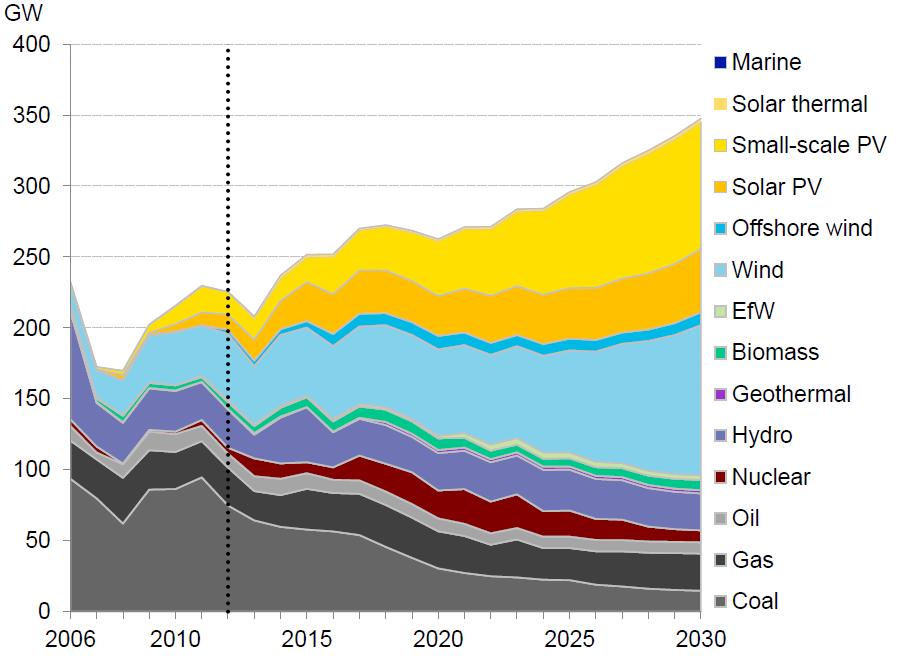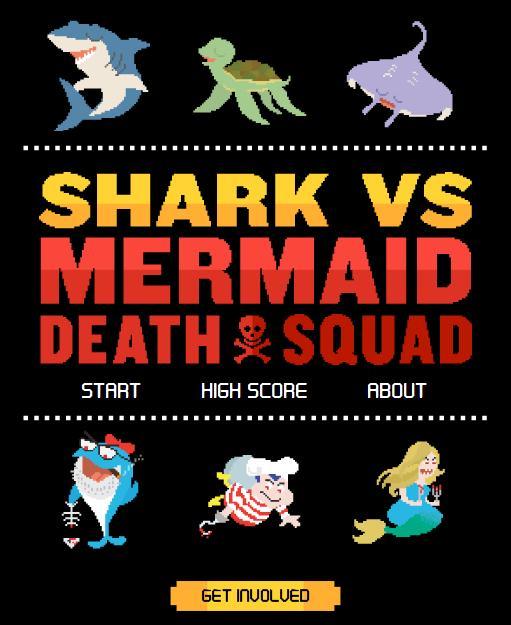Renewables, it’s time to lead. By 2030.
Fossil fuel enthusiasts need to wrap up warmly by 2030. Because major investments in new power supply will be handed over from coal and gas to renewables, worldwide. They will account for up to 70 percent, according to calculations by Bloomberg New Energy Finance. Where do these numbers come from? Well, Bloomberg analysts reviewed gas prices, carbon prices, counted in the dwindling price of green energy technology, and overall energy demand. The result is that solar and wind are going to beat fossil fuels like coal and natural gas by 2030.

Annual installations of new power sources, in gigawatts; over time.
Picture credit: Bloomberg New Energy Finance
„The likeliest scenario implies a jump of 230 percent,“ they say, compared to 2012. In total numbers: $630bn will be invested per year. According to Bloomberg New Energy Finance wind and solar will take up the largest shares of new power capacity, accounting for 30% and 24% respectively.
But, of course, the good news comes with a flipside: Fossil fuels historically are mounted to the power markets that even this projected massive growth is not enough to change completely towards sustainability. By 2030, non-renewable sources will still account for half of the world’s total power supply, according to the analysis.
Earth Day 2013 – the day google releases the tiny bears
Today is Earth Day, a day to raise the awarness for climate protection and to make clear we don’t have a backup-earth waiting in the cellar if we have wasted this one. The Earth Day movement is has quite a long tradition, this year it’s 43 years old, a milestone Google dedicates one of it’s occasional doodles.
Also these dedications have a long tradition, starting with two aliens looking at our planet in 2003 over melting polar ice in 2007 up to animated flowers in 2012.
This year’s the design is more elaborate. You will see a scene of hills with snow-capped mountains and a lake teeming with fish, bears peeping out caves, rain falling from clouds if you click them. It’s playfull, cute and may work as a mind-opening tool to make sure everyone knows what gem we live on.
Google has started a few efforts lately to support a greener environment. It’s funded renewable energy projects and published its carbon footprint for the first time.
Earth Day was born in the US in 1970. It’s idea is to activate “individuals and organizations to strengthen the collective fight against man’s exploitive relationship with the planet.”
Earth Day was born in the US in 1969, presented as a concept at the UNESCO conference in San Francisco. It’s idea was and still is to activate “individuals and organizations to strengthen the collective fight against man’s exploitive relationship with the planet.”
At the same time Gaylord Nelson U.S. Senator from Wisconsin back then thought about a national day of the environment after witnessing the ravages of the 1969 massive oil spill in Santa Barbara, California. The idea became popular, so since 1970 “Earth Day“ became a regular and steady growing event. During the 1990s the day crossed borders and became what it is today, a worldwide supported day in honor of the earth.
United States and China team up against climate change
Two of the main contributers to global greenhouse gas emissions are working on a collaboration to finally take on the world’s biggest challenge. “Both sides recognize that, given the latest scientific understanding of accelerating climate change and the urgent need to intensify global efforts to reduce greenhouse gas emissions, forceful, nationally appropriate action by the United States and China – including large-scale cooperative action – is more critical than ever”, a statement, both countries released lately, reads.
US Secretary of State John Kerry visited Beijing during his tour through the region. The paper could be seen as a step forward, as both states, the world’s two biggest economies, are business rivals. China describes itself as a developing country, which emits far less carbon per capita and therefore should not have to bear the same burden as advanced economies in tackling the problem.
“By agreeing to raise the issue of climate change and energy policy to the ministerial level … we put on an accelerated basis at a higher level our joint efforts with respect to energy and climate”, US Secretary of State Kerry said. “And I think that globally that will be a very significant step and significant message.”
According to Chinese State Councillor Yang Jiechi , the nation’s top foreign policy official, the two sides would “strengthen practical cooperation” in areas including the economy, energy and environmental protection.
“Such action is crucial”, the statement adds, “both to contain climate change and to set the kind of powerful example that can inspire the world.”
A legendary soccer player teaches how to change the world
Soccer can be a very successfull tool when it comes to urgent things that have to be done, climate change for example. In Namibia, the Soccer-initiative “Global United FC” fits the role of a kickstarter very well. The players visit schools to get in touch with pupils and to spread the word about how the climate can be protected. Former professional soccer stars from all over the world take part. In Nambia all eyes are especially on Lolo Goraseb, who is a local soccer legend and today the president of the Namibia Football Players Union. Our reporter Thomas Mandlmeier had the chance to interview him during a “Global United FC” event.
Lolo Goraseb played longtime for the “Brave Warriors,” Namibias National team where he debuted at the age of 19 and went on to become the third most capped Namibian of all times. He started his career at the age of 17 for “Black Africa,” a Namibian football team from Katutura (Windhoek) that takes part in the Namibia Premier League.
Lolo Goraseb, Namibian Soccer Legend from DW_Global Ideas on Vimeo.
Hit the buttons to beat the “Mermaid Death Squad”
What sounds like a name for a pretty cool comic metal band is a new online game created by Greenpeace. It’s meant to create awareness about unsustainable tuna fishing. It sets you up against some real nasty-looking, dangerous creatures who want to put you in a tuna can. Greenpeace gives you the chance to battle some well known canned tuna brands – Chicken of the Sea, Bumble Bee and Mermaid – or at least iterations of their mascots. And make sure you don’t get caught.
The idea behind this pacman-like arcade game is obvious. The industrial tuna fishing industry’s big ships catch a lot more than just tuna. Sharks, manta rays, turtles and several marine creatures are caught up and killed every day in the fishing nets. The canned tuna brands mentioned above are the bad guys who use Fish Aggregating Devices (FADs) and longlines to kill an estimated 100,000 tons of bycatch, the games explains.
So it’s up to you to help. Choose to be a shark, manta ray or turtle racing down the aisles of a stylized supermarket to free the tuna from the cans before the bad guys catch you. If you lose, it’s literally game over for the ocean.










Feedback